Free content
-
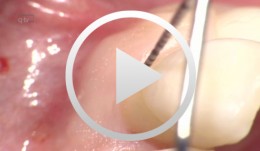

-


Covering a Recession with a Soft Tissue Transplant
Heinz, Bernd / Jepsen, SörenObjectives: Use of a soft tissue graft for recession coverage at tooth 23 and for gingival augmentation. Content: 1. Incision around tooth 23, intra-sulcular preparation, mobilization of coronal sliding flap, and pre-flap preparation. 2. Root smoothing, reduction of ground cavity with diamond burs from Perioset system. 3. Preparation and harvesting of connective tissue flap from palate, Emdogain application, and wound closure. 4. Placement of interrupted interdental sutures for fixation of connective tissue flap. -


Fiberglass frameworks in removable prosthodontics
Bücking, Wolfram -


Soft Tissue Management in the Aesthetic Zone
Daniel ThomaExpert presenter PD Dr. Daniel Thoma is a Head of Academic Unit at the Clinic for Fixed and Removable Prosthodontics and Dental Material Sciences, University of Zurich, Switzerland. Long-term successful outcomes with implant therapy are based on a number of parameters. Among these, the critical assessment of the peri-implant soft tissues and subsequent therapeutical interventions are considered key factors. -
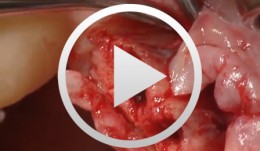

Bone Spreading, Bone Condensing
Streckbein, RolandContent: Surgical flap creation and elevation; Use of drill template for exact determination of implant position; Implant site creation; Site preparation / tapping; Bone compaction; Insertion of the implants; Impression-taking; Wound closure; Later implant insertion; Dental lab work; Creating the model with laboratory implants; Shaping the bar frame; Adapting the laser welded frame to the model; Manufacturing the tooth replacement, Fitting the bar into the tooth replacement; Finishing work. -
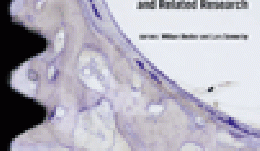

-
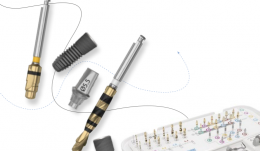

-
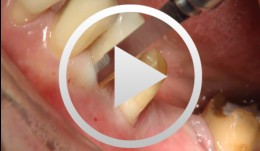

Periodontal Preserve Therapy (Examples)
Clotten, StefanContent: - Periodontal maintenance therapy for teeth 34 and 35, including the regeneration of a bone defect using bone replacement material, collagen membrane and sutures. - Curettage for treatment of periodontal pockets. - Treatment of gingival pressure sores caused by tight-fitting orthodontic apparatus. - Incision of buccal attachment to relieve gingival pressure for elimination of gingival recession. -
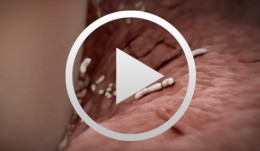

Cell-to-Cell Communication - Inflammatory Reactions
Stadlinger, Bernd / Terheyden, HendrikVisualizing the invisible while experiencing a fascination with science is the great challenge that Cell-to-Cell Communication, representing an all-new genre, has set out to meet. A spectacularly sophisticated computer animation in HD quality depicts the highly complex processes of intercellular interaction during an inflammatory periodontal reaction complete with the messenger molecules implicated. The various cell types constitute the main cast of the film, using a finely tuned communication process in their quest to destroy the bacterial invaders, with messenger molecules as supporting cast. A stunning didactic and dramatic experience! Outline: - Biofilm - Gingivitis and the Innate Immune Defense - Periodontitis and the Adaptive Immune Defense - Cleaning and Regeneration -


Aesthetic upper anterior implant placement case
Dr. Dominik BüchiDr. Dominik Büchi performed a ridge preservation to keep the soft tissue volume. He then placed an implant 8 weeks later with simultaneous GBR. The final emergence profile was created by a fixed provisional crown. -


Short and narrow implants, how far can we go?
Christoph Hämmerle, José NartIn this webinar moderated by Prof Ronald Jung and Dr. Adrián Guerrero the expert presenters Prof. Christoph Hämmerle and Dr. José Nart discuss about the importance and benefits of using short and narrow implants. -
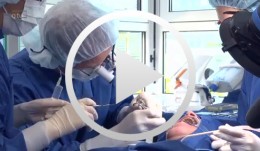

-
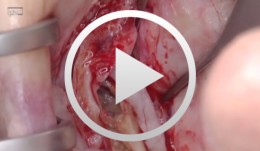

Live surgery Surgical treatment of bone necrosis
Schultze-Mosgau, StefanOutline: - Surgical wound debridement - Sequestrotomy - Preparation of the soft-tissue bed - Plastic, tension-free, saliva-proof wound closure List of materials Basic surgical tool set: - Surgical blade - Preparation scissors - Pair of tweezers - Suture materials -
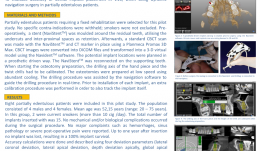

REAL-TIME NAVIGATION: THE BEGINNING OF A NEW ERA IN GUIDED IMPLANT SURGERY
Objectives: To demonstrate that dynamic guided surgery is as predictable as conventional surgery. Methods: Partially edentulous patients requiring a fixed rehabilitation were selected for this pilot study. No specific contraindications were established, and smokers were not excluded. An impression was taken pre-operatively using an irreversible hydrocolloid (Cavex CA37®) to fabricate a diagnostic cast for moulding the surgical stent (NaviStent®). Afterwards, a standard cone-beam CT (CBCT) scan was made with the NaviStent® in place using a Planmeca Promax 3-D Max®. Images were converted into DICOM files and transformed into a 3-D virtual model using the Navident® software. The potential implant locations were planned in a prosthesis-driven way. For preparing the osteotomy, the drilling axis of the handpiece and the twist drills were calibrated. The osteotomies were prepared at low speed using a high level of cooling. The navigation software guided the drilling procedure in real time. Before installing implants, an extra calibration procedure was performed for tracking the implant. The aim of this pilot study was to determine the clinical outcome up to 12 months post-operatively for implants installed using the Navident® guided surgery system. Results: Partially edentulous men (n = 6) and women (n = 7) were included in this pilot study (mean age 52.15 years; range 20–75). Out of these 13 patients, two were current smokers of more than 10 cigarettes per day. Twenty implants were inserted. No mechanical or biological complications occurred during the surgical procedure, and no major complaints were reported, such as hemorrhage, sinus pathology or severe post-operative pain. No implants were lost up to 1 year after insertion, resulting in 100% implant survival. Conclusions: Based on the results of this pilot study, real-time navigation is a promising technique. However, there is not yet enough evidence to show that the method is as safe and predictable as conventional implant surgery. -
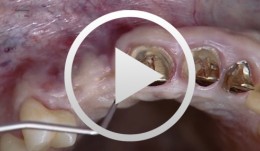

Implantation with Simultaneous Augmentation
Grunder, UeliProcedure: - Case evaluation - Incision technique - Implant placement - Membrane adjustment and fixation - Introduction of replacement material - Flap mobilization - Suture technique Contents: Implantation was desired for replacement of a missing upper canine tooth and the adjacent lateral incisor tooth. The initial case evaluation revealed a relatively narrow gap between these two teeth in addition to extensive hard and soft-tissue defects. We selected an incision technique that made it possible to do the augmentation work yet subsequently achieve a tension-free flap closure. Since the bony defect was large while the available space was limited, we had to go for the best possible compromise in regard to implant insertion. After the implants had been inserted, augmentation was carried out using a non-absorbable, titanium-reinforced membrane, bone replacement material, and an absorbable membrane. Extreme flap mobilization was needed to achieve flap closure. An optimal suture technique was used to complete the surgery. -
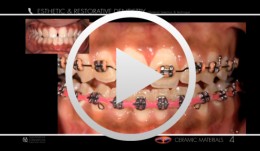

Esthetic and Restorative Dentistry - Ceramic Materials
Terry, Douglas A.
Most Popular
-
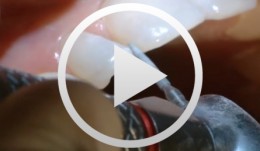

Incremental layering composite restoration in the anterior maxilla
Dietschi, DidierMorphological abnormalities such as peg-shaped laterals are quite frequent dental problems which must be addressed by restorative means. An ideal aesthetic correction can be achieved with minimal or no-loss of tissue, what is known as "Minimally Invasive Dentistry", a concept becoming popular also in Aesthetic Dentistry. This video demonstrates the reconstruction of two lateral incisors with direct composite application, following the "Natural Layering Concept", which implies the use of separate dentin and enamel increments, mimicking the natural tooth anatomy. Step by step procedures will be detailed, which include shade selection, placement of the rubber dam, adhesive procedures, dentin and enamel build-up and finishing-polishing procedures, which finalize the restorative work. By following a precise and meticulous operative protocol, perfectly natural looking restorations can be produced, in a predictable way. -
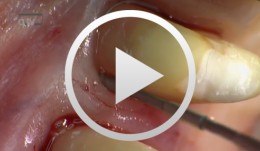

The Carnevale Technique: Hemisection/Trisection of Molars with Furcation Involvement
Hürzeler, Markus B.Procedure: - Apical Flap Repositioning - Trisection of the Upper Molar - Extraction of the Distobuccal Root - Tangential Preparation of the Abutment Teeth - Temporary Relining Contents: Molars with furcation involvement have a shorter long-term prognosis for tooth retention than single-rooted teeth. Apart from replacing these teeth with implants, they can also be treated by hemisection or trisection with the goal of eliminating furcation and creating single-root conditions. Studies on the long-term stability of teeth treated by hemisection / trisection show mixed results. Some investigators have found failure rates of up to 40 percent. In Gianfranco Carnevale's group, on the other hand, success rates of more than 90 percent have been reported for a 10-year follow-up period. Pretreatment: Initial work on the abutment teeth, which had grade II-III furcation involvement, was done six to eight weeks after conservative periodontal therapy in preparation for placement of the long-term temporary. Preparation was done tangentially, up to the bone level, to spare as much dental hard tissue as possible while eliminating all recesses and root concavities. A metal-reinforced long-term temporary was used to splint the prepared teeth. Endodontic treatment of the affected teeth was subsequently performed. Surgical procedure: Apical displacement of the gingiva around the involved teeth was done before incision. A mucosal fl ap was created on the buccal and palatal sides. Trisection of the teeth was then performed. After dissecting and excising the distobuccal root, intraoperative preparation of the abutment teeth was carried out. Temporary relining was another important step, the objective of which was to splint the root and to prevent tilting. Further treatment: Impressions for the defi nitive restoration were made six months postoperative. The restoration margins of the tangential preparation were defined using a master model. The definitive reconstruction had fine metal margins. -


Ballon Lift Control System, Arbeitsanleitung und Fall aus der Praxis
Heuckmann, Karl-HeinzIn diesem Beitrag mit Dr. Dr. Karlheinz Heuckmann, Chieming am Chiemsee, geht es um eine einfach und zeitsparende Methode für eine Sinusbodenelevation. Dr. Heuckmann hat zusammen mit dem Professor für Anatomie der Universität München, Dr. Klaus-Ulrich Benner, das von Meisinger vertriebene Balloon-Lift Control-System entwickelt. Mit der Balloon-Technik sind Sinuselevationen erstmals minimal-invasiv möglich und darüber hinaus in einem Bruchteil der bisher benötigten Zeit. Die Anwendung des Balloon-Lift Control-Systems ist leicht erlernbar und die Patienten sind überrascht, wie schnell der Sinuslift und die Augmentation erledigt sind.
Recommended to You
-


-
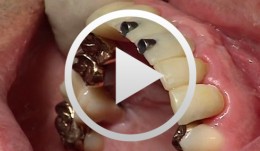

-
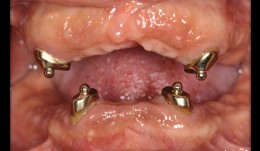

Esthetic improvement in implant-supported fixed and removable dentures
Christian RamelHow to improve esthetics and stability of implant-supported fixed and removable dentures.










